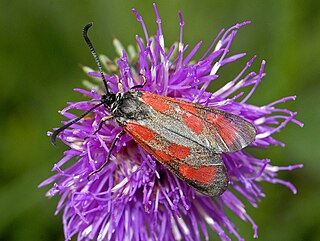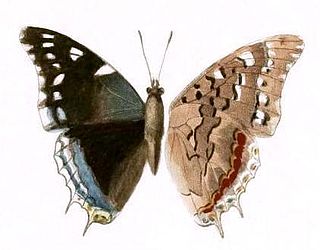
Zygaena transalpina is a moth of the family Zygaenidae.

The purple-edged copper is a butterfly of the family Lycaenidae.

Zygaena is a genus of moths in the family Zygaenidae. These brightly coloured, day-flying moths are native to the West Palearctic.

Zygaena carniolica, sometimes described as the crepuscular burnet or eastern burnet, is a member of the family Zygaenidae.

Zygaena loti, the slender Scotch burnet, is a moth of the family Zygaenidae. It is a diurnal moth characterized by a black body, light colored legs, and red spots on its wings. The caterpillars are a yellow-green color and usually molt out of dormancy in late February to early March. The larvae feed on plants from the family Fabaceae until they enter their pupal stage and mature into adults in May to early June. For mating, Zygaenidae exhibit a dual-partner finding strategy, where females use pheromones while assuming a calling position, and males exhibit a patrolling behavior where they utilize both vision and the olfactory receptors in their antennae to locate a potential mate.

Zygaena exulans, the mountain burnet or Scotch burnet, is a moth of the family Zygaenidae.

Zygaena lonicerae, the narrow-bordered five-spot burnet, is a moth of the family Zygaenidae. The species was first described by Theodor Gottlieb von Scheven in 1777.

Zygaena purpuralis, the transparent burnet, is a moth of the family Zygaenidae.

Charaxes guderiana, the blue-spangled emperor, Guderian's charaxes or blue-spangled charaxes, is a butterfly of the family Nymphalidae. It is found in southern Africa.

Zygaena osterodensis is a moth of the family Zygaenidae.

Zygaena romeo is a moth of the Zygaenidae family.

Zygaena sarpedon is a moth of the Zygaenidae family. It is found in France, Italy and on the Iberian Peninsula.

Zygaena hilaris is a species of moth in the family Zygaenidae.

Zygaena brizae is a species of moth in the Zygaenidae family. It is found in France, Italy, Austria, the Czech Republic, Poland, Slovakia, Hungary, the Balkan Peninsula, Moldova, Ukraine, Russia and Georgia.

Zygaena cynarae is a species of moth in the Zygaenidae family. It is found from France east to Russia.

Zygaena erythrus, common name sluggish burnet, is a species of moth in the family Zygaenidae.

Zygaena punctum is a species of moth in the family Zygaenidae. It is found in Poland, the Czech Republic, Slovakia, Austria, Slovenia, Italy, the Balkan Peninsula, Moldova, Ukraine, Russia and Turkey.

Zygaena angelicae is a species of moth in the Zygaenidae family. It is found in Central Europe, from Greece to southern Germany and Thuringia. Z.angelicae has blue-black or green-black forewings, whose inner angles are strongly rounded off. On the forewings there are five or six red spots, two of which are always close together. In the five-spotted individuals, the spots on the underside of the wings are connected by a red stripe, in the six-spotted ones this is a large patch. The black margin of the red hind wings is wide. The antennal club is white at the tip less so than in Zygaena transalpina and the white may be completely absent. The wingspan is 30–33 mm.

Zygaena rhadamanthus is a species of moth in the Zygaenidae family. It is found in France, Spain, Portugal and Italy.

Charaxes etheocles, the demon charaxes, is a butterfly in the family Nymphalidae. It is found in Senegal, Guinea, Sierra Leone, Liberia, Ivory Coast, Ghana, Togo, Nigeria, Cameroon, Gabon, the Central African Republic, the Republic of the Congo, Angola, the Democratic Republic of the Congo, Sudan, Ethiopia, Uganda, Kenya, Tanzania and Zambia.





















